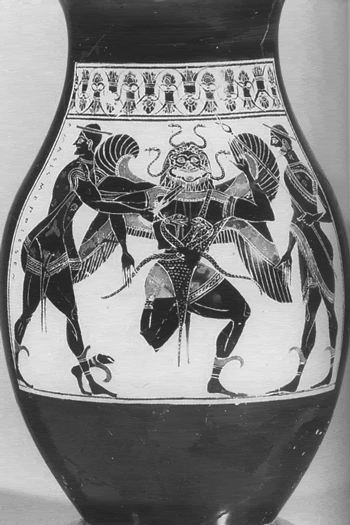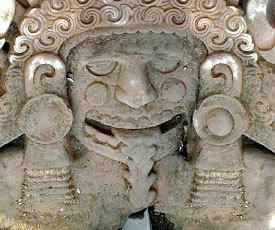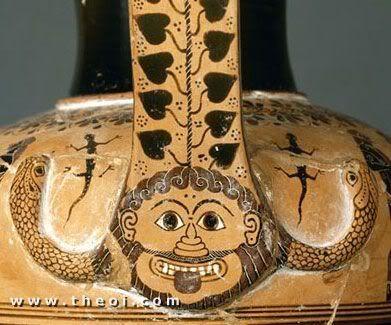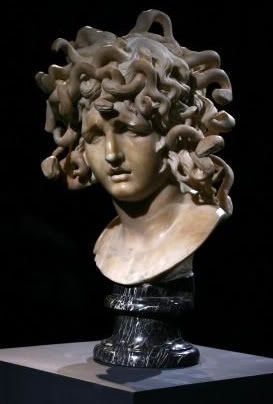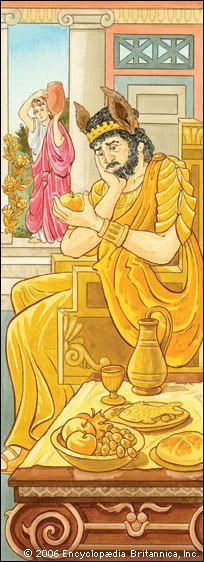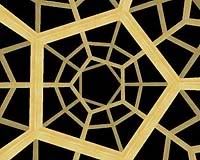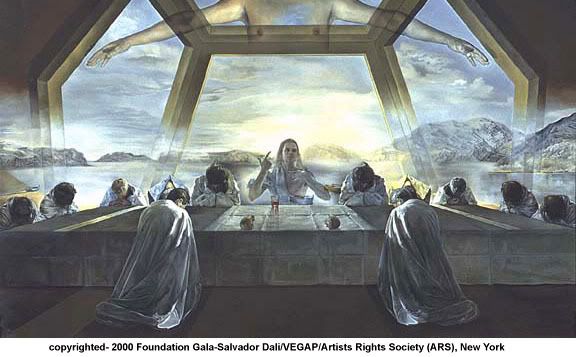Continuing on the theme of deities that I think are similar to Medusa, here are a couple more of interest. Here is the goddess Kali as her associated god Durga:

Kālī is the feminine of kāla "black, dark coloured." ... The homonymous kāla "appointed time", which depending on context can mean "death", is distinct from kāla "black", but became associated through popular etymology. The association is seen in a passage from the Mahābhārata, depicting a female figure who carries away the spirits of slain warriors and animals. She is called kālarātri (which Thomas Coburn, a historian of Sanskrit Goddess literature, translates as "night of death") and also kālī (which, as Coburn notes, can be read here either as a proper name or as a description "the black one"). Kali's association with blackness stands in contrast to her consort, Shiva, whose body is covered by the white ashes of the cremation ground (Sanskrit: śmaśāna) in which he meditates, and with which Kali is also associated, as śmaśāna-kālī.
In the above picture Kali/Durga is seen with the typical dishevled hair of other Medusa related figures. Durga is translated as "the invincible," which is interesting when considering that although Medusa was mortal, her sister Gorgons were invincible.
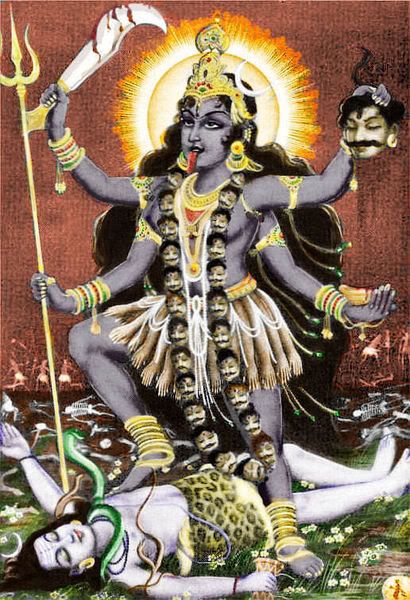
This is a more telling picture of Kali. Here she is more blue than black, but we can also see the parallels to Medusa more clearly. Kali holds the severed head of a slain warrior, which she decapitated with her sword. This should remind anyone familiar with the Medusa tale that Medusa was decapitated by Perseus, shown here in a very similar pose (with an identical sword).

Kali holds the Trident, the weapon of choice for Neptune who is the Roman version of Medusa's 'lover' (and/or rapist), Poseiden. She is sticking out her tongue, has four arms to Medusas four wings, and snakes are seen on the ground around Shiva. More importantly her pitch black and wild hair is eclipsing the sun. Even more telling is the crescent moon (a shared symbol with Sin) on her crown which is placed over the sun as well. Kali, who becomes drunk on the blood of her victims on the battlefield, dances with destructive frenzy. Blood drinking seems to be part of each of the deities I've presented, except oddly enough Medusa herself.
In Greek mythology, blood taken from the right side of a Gorgon could bring the dead back to life, yet blood taken from the left side was an instantly fatal poison.

Moving on the South America, here is an Incan figure (with "Medusa" face) with an inset picture of an eclispe to compare to the drawings on it's face. During the time that the Nazca Lines were being scratched out in the martian surface of Peru there were many total eclipses visible in that region. It is thought that the Inca viewed the eclispe as the eye of God and drew the pictures to appease him. Just for fun, here is a famous Nazca drawing, a monkey with a labyrinth spiral tail. (Hmm a primate and a stargate, why does that seem familiar?)

Medusa the Gorgon.Medusa was a stunning blond bombshell until Athena got a hold of her. Reminds me of the old movie about cavemen tribes. The “good” cavemen were all blond and the “evil” cavemen all had dark hair. Anyways, the single eye is quite provocative (as is the single TooTH but I’ll skip that), as single eye’d deities are quite common. Usually a single eye'd god is... well is God. Associated with the single orb of the Sun, his bright eye, and having some story as to why the Moon isn’t quite as bright; having been lost or pecked out or donated to a fountain of wisdom, etc. Focusing on Medusa, it’s quite fortuitous that after having written about single eyed figures so many times I find that Medusa is one as well. Anyways the hair turning from light to dark, and the single eye basically clinches the moon symbolism for me.
According to Ovid (Metamorphoses), Medusa alone had serpents in her hair, and this was due to Athena (Roman Minerva) cursing her. Medusa had copulated with Poseidon (Roman Neptune), who was aroused by the golden color of Medusa's hair, in a temple of Athena. Athena therefore changed the enticing golden locks into serpents. Aeschylus says that the three Gorgons had only one tooth and one eye among them, which they had to swap among themselves.
But the moon and sun are quite similar, and even overlap in the awsome display of an eclipse. Being able to predict the cycle of eclipses would be a show of power for any society, who could then claim to be able to predict the future. Once they figured out the moons orbit, and the sometimes erratic eclispe cycle, they could use the portent in the sky to amaze their subjects; similar to Apocalypto where the eclispe (which was almost certainly known in advance) was ended when the god was appeased with blood sacrifice. One such famous calendar from South America is the Aztec Sun Stone, or Aztec Calendar.
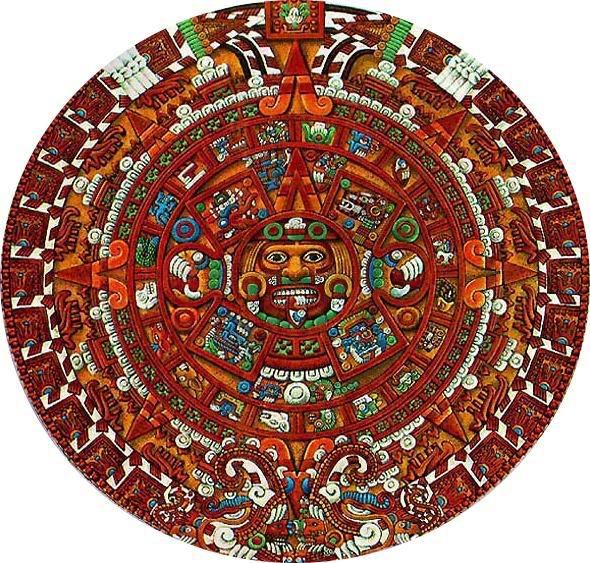
Historically, the Aztec name for the huge basaltic monolith is Cuauhxicalli Eagle Bowl, but it is universally known as the Aztec Calendar or Sun Stone. It was during the reign of the 6th Aztec monarch in 1479 that this stone was carved and dedicated to the principal Aztec deity: the sun. The stone has both mythological and astronomical significance. It weighs almost 25 tons, has a diameter of just under 12 feet, and a thickness of 3 feet.This calendar is basically the same as the famous Mayan calendar. By now you should be able to pick out all the familiar symbols. There's the face with wide-open eyes, and the open mouth showing the teeth with the tongue sticking out. "The tongue, stuck out is the form of an obsidian knife, indicates that the diety demands to be fed with blood and human hearts." This head has golden hair, as it is the sun god's face, Tonatiuh, or Lord of Heaven. On either side of the bodyless head is what appears to be two serpents. Described as the "claws of the sun god which are suspended in space," these beings have a single eye and eyebrow and a human heart in their teeth/claws. Instead of the four wings of Medusa or the four arms of Kali, there are the four Suns of the four previous epochs around the face.
Continued in the last article, part 4.


